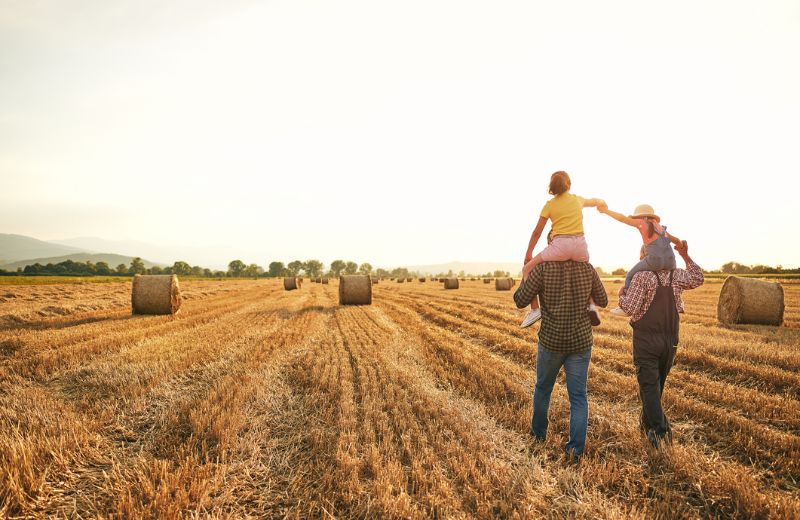not featured
2025-05-29
5/29/2025
Agriculture
published
%20(24).jpg)
9 Money Savings Tips For Your Madison County Farm
Whether you’re starting a farm here in Arkansas or have been running a successful ag business for years, the rising costs of agriculture, coupled with recent inflation, may leave you wondering how to ensure that your Huntsville farm is profitable—now and for years to come. If you’re worried about the current costs of farming, you’re not alone. In fact, according to Successful Farming, a recent survey showed that most farmers—75%—believed inputs would cost at least 20% more this year than 2021 due to inflation, while nearly half thought the increase would be more than 40%.
While there’s no secret formula for balancing your budget this year or any, there are some things you can do to stretch your dollar, save money, or even earn a little extra income, without taking drastic measures. Below you’ll find some of our top suggestions for how to do so!
Don’t Skip the Routine Equipment Maintenance
Per the USDA’s Farm Expenditures Report, Arkansas farms spend about $10,000 per year on equipment costs alone. While most farm equipment should last 10 to 15 years, you can cut or add years of life from your equipment depending on how well you maintain it. Check out your operator’s manual for how many hours should pass between routine maintenance intervals, and stick strictly to the schedule the manufacturer recommends. Farms.com has a general maintenance checklist you can follow, but keep in mind there are important seasonal tasks in the spring and winter to keep up with as well. Lastly, you can save time and money by doing certain things like changing the oil yourself. Check out Hobby Farm for an easy to follow step-by-step guide.
Lastly, if a piece of equipment is nearing the end of its lifespan and is costing you a small fortune in annual repairs, it might make sense to use an equipment loan to upgrade to a newer, more efficient machine, rather than throw good money at something that is past its prime. Keep in mind just like maintenance costs, interest on loans is also tax deductible.
Prioritize Important Farm Repairs and Projects
According to the same USDA report, the average farm in Arkansas spent about $15,000 in 2019 on supplies, repairs, and construction—more than chemicals, fertilizer, or labor—but still probably not enough to cover everything on your wish list for your farm. As farms age and farm needs change, there are endless things you could do on your farm to improve it and keep it in good repair. The key is to prioritize your needs so that you don’t overspend. Here are some ideas on how you can make your dollar stretch the farthest:
- Save non-urgent repairs you can complete on your own for seasonal downtimes. If you’re too busy to address a repair during peak planting or harvesting times, but it’s something that can wait, find a way to work it into your schedule to save money on labor costs.
- If a building is in need of major repairs, prioritize the ones that will make the most difference first. For instance, if a barn needs new siding and a new roof, start with the roof, the most vulnerable part of the structure—without adequate weather protection, the rest of the structure will sustain irreversible damage, shortening its lifespan drastically.
- Work on projects that relate to your main income stream first. If you’re a dairy farmer and will need to replace the ventilation system in your cow shed, focus on that before starting a side project. In other words, don’t start something new until your current business needs are met.
- If it will cost you more down the line if you wait than if you address it now, do it now. The longer you let something deteriorate, the more extensive repairs will be. Getting a loan to address an issue early on could save you money in the long run.
Keep Good Inventory Records
With farm expenses rising faster than commodity prices, you may find your usual budget for things like inputs, seed, and supplies no longer covers your annual needs. Keeping solid records of your inventory including date of purchase, price at the time of purchase, and how much you use each year, can help save money in three ways:
- First, you can use older inventory first, to avoid waste from spoilage.
- Secondly, you can avoid buying more than you need, or buying something you already have.
- Thirdly, by keeping track of prices, you can stock up when prices are low (many items have seasonal or market fluctuations). Even if you know a certain price is high but you need that item immediately, if you know your normal use you can buy the minimum quantity to avoid spending more than you need to.
Remember, even if you don’t use the entire supply of inventory that year, you can still report it as a tax deduction under most circumstances. For more information, check out Ruraltax.org’s Prepaid Farm Expenses guide.
Keep Your Farm’s Savings in an Interest-Bearing Ag Savings Account
If your farm bank account tends to carry a higher balance—even seasonally—consider the extra boost you could get by transferring those funds to an interest-bearing account. Both money market and commercial savings accounts give you reasonable access to your funds, year round. And if you know you won’t need a certain amount for even a brief time (like 6 months), you could get even more interest by putting your extra cash in a commercial certificate of deposit. Visit our Ag Savings page for more details on the many savings products we can offer your farm business.
Explore Energy Alternatives
As energy costs rise, consider investing in wind turbines or solar energy for your farm, as well as methods of improving your farm’s energy efficiency. The USDA even offers funding, through their Rural Energy for America Program (REAP). According to their website, REAP “provides guaranteed loan financing and grant funding to agricultural producers and rural small businesses for renewable energy systems or to make energy efficiency improvements.” And this doesn’t just apply to your use of energy for buildings. Farmers can also apply for funds for “new energy efficient equipment and new system loans for agricultural production and processing.” Loans are available to cover up to 75% of project costs, while grants (ranging from $1,500 to $500,000) are available for up to 25% of costs. If you don’t want to cover these costs yourself upfront, many power cooperatives will even pay you income each year to build equipment on your land.
Worried that installing these features will occupy too much of your farm’s land? Keep in mind that solar panels can be affixed to existing structures, and wind turbines have a very small footprint. In fact, according to the American Farm Bureau Association, “Each turbine uses less than half an acre, so farmers can plant crops and graze livestock right to the turbine's base. Most can continue to use about 95 percent of the land around wind turbines.” And for ways to reduce your energy expenses with solar power, check out this guide from SARE.
Reduce Your Need for Fertilizer
Many farms, especially those that still maintain a multi-faceted approach to agriculture, could benefit from using their existing resources to make their own fertilizers and reduce fertilizer dependency. Farm Progress notes several ways to reduce fertilizer costs on your cattle farm, but the easiest way might be to simply allow your livestock to graze right on your pastures, instead of harvesting hay and then fertilizing the bare fields. Incorporating legumes into your forage can also help increase nitrogen levels.
Additionally, Eco Farming Daily offers a number of ways to work with nature instead of against it to decrease reliance on inputs, thus decreasing operating expenses. Suggestions include reducing the amount of biomass leaving the farm to less than 8%, and using homemade fertilizers for small-scale production.
Additionally, Eco Farming Daily offers a number of ways to work with nature instead of against it to decrease reliance on inputs, thus decreasing operating expenses. Suggestions include reducing the amount of biomass leaving the farm to less than 8%, and using homemade fertilizers for small-scale production.
Reuse When You Can
There are many things you can reuse—either items on your own farm, or in your community—to save money while also reducing waste. Here are a few examples:
- Reuse chicken litter to save money and prevent Salmonella.
- Reuse feed bags as trash bags.
- Reuse kitchen scraps as feed. You can even ask grocery stores, bakeries, farmers’ markets, and restaurants for their food waste.
- Reuse brushes from street sweepers for cattle rubs.
- Reuse wasted feed as fertilizer.
- Reuse (dried) manure as bedding.
- Reuse grain that’s not fit for human consumption as animal feed.
- Reuse wet brewers’ grains leftover from beer brewing for cattle feed.
- Reuse crop stubble by letting your cattle graze after harvest (this also adds nutrients through manure!).
Refinance Farm Loans
Although farm interest rates are slowly rising, they are still significantly lower than they were in the past, which, as Agricultural Economic Insights points out, were as high as 10% in 2000. In fact, as of May 2022, interest rates of USDA direct loans are go up to 3.75% (though may rise more soon), while guaranteed farm loans through your bank also offer competitive, market-based rates. If the current interest rate is lower than your farm real estate or other ag loans, it might make sense to refinance to a lower rate. To learn more about some popular loan products we have to offer at CS Bank, check out our pages for Farmer Mac Loans, SBA (Small Business Administration) Farm Loans, and FSA (Farm Service Agency) Loans.
Explore Arkansas NRCS Conservation Programs
There are numerous grant and cost-share programs available to Arkansas farmers interested in exploring innovative conservation techniques on their land. Past projects for Conservation Innovation Grants have included experimentation with cover crops and soil health demo trials. Participating in the Conservation Stewardship Programs, like the new CSP Grasslands Conservation Initiative, can earn you $18 an acre for adhering to best practices for preserving grazing land. And the Environmental Quality Incentives Program (EQIP) provides financial assistance to “implement approved conservation practices on eligible land or to help producers develop Conservation Activity Plans (CAP) to address specific land use issues.” For more information and financial assistance opportunities, visit the Arkansas NRCS Conservation Programs page.
How CS Bank Can Help You
At CS Bank, we know that increasing farm costs can hurt your bottom line, and being a successful farmer today means being savvy enough to make the smartest spending choices when it comes to your ag business. With a range of agricultural banking products and years of experience, we can help you do just that.
We live, work, and farm in your community. Our ag lenders are not only farm lending experts, they’re also farmers, who understand your needs. With locations throughout Northwest Arkansas and Cassville, Missouri, we’re a convenient choice for all your ag lending needs, from poultry loans and livestock loans, to loans for ag real estate and farm operations. Talk to a Huntsville ag lender today to see how we can help your farm business!


